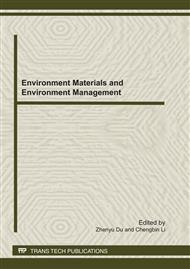p.233
p.237
p.243
p.249
p.253
p.258
p.263
p.267
p.270
Study on Regional Water Environment Carrying Capacity during the Process of Urbanization - A Case in Jining City
Abstract:
The regional water environment carrying capacity (WECC) is defined as the bearing capacity of water environment for human activity in a certain state, a region and a time, reflecting the coordination between regional water environment and socio-economic development. Using the fuzzy comprehensive assessment principle, on the based of determining the weight of each index and the classification standard of index, the paper evaluated the water environment carrying capacity of Jining City form 2007~2009. The results show that the water environment carrying capacity of Jining City is still at a relatively low level, and remains to be improved further, which should provide scientific basis for the regional water management and sustainable development strategies.
Info:
Periodical:
Pages:
253-257
Citation:
Online since:
July 2011
Authors:
Keywords:
Price:
Сopyright:
© 2011 Trans Tech Publications Ltd. All Rights Reserved
Share:
Citation:


